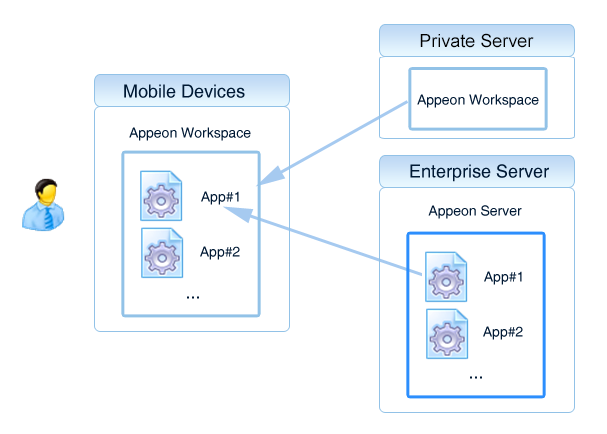Appeon Workspace is an alternative method for distributing the native mobile application. In summary, the PowerServer native mobile application can be distributed and accessed in the following two ways:
-
Traditional methods for pure native applications
By building the PowerServer mobile application to standard iOS application archive (IPA) file or Android application package (APK) file, the following distribution strategies can be used:
-
End-users can perform the installation wirelessly by using a direct URL.
-
IT administrators can use a private MDM server to instruct managed devices to install the native mobile app automatically.
-
Developers can upload and distribute publicly via the online app stores, such as the Apple App Store, Google Play, etc.
-
-
Special method provided by PowerServer -- Appeon Workspace
Developers only need to deploy the PowerServer native mobile applications to PowerServer via the PowerServer Toolkit. End users will first download and install Appeon Workspace to the device, and then download, install and run the PowerServer native mobile application in Appeon Workspace.
Appeon Workspace is highly recommended over the traditional methods, because it has the following advantages:
Advantage 1: Simplify distributing and running applications
The traditional methods aforementioned are commonly recognized as time-consuming and cumbersome; especially the 3rd method, though most widely used now, it puts the application through lengthy approval process, and it poses high risk of being rejected. Besides that, each OS vendor runs their own online app stores and follows their own rules and procedures to approve applications, developers will need to spend tremendous time and efforts getting the application approved in each of these stores.
Appeon Workspace will connect to the PowerServer, and download, install, and run the PowerServer mobile apps, as illustrated in the following diagram:
-
Developers distribute Appeon Workspace over-the-air (such as via email or Web site);
-
Developers deploy their mobile apps to the application server;
-
End users first install Appeon Workspace on their devices and then add and run the deployed PowerServer mobile apps in Appeon Workspace.
Advantage 2: Facilitate application upgrade (especially for apps hosted as SaaS)
Reason is mostly the same as described above. Without needing to build and distribute the IPA or APK file, developers only need to deploy the mobile apps to PowerServer by using the PowerServer Toolkit. When Appeon Workspace runs the mobile apps, it will automatically check for the update and upgrade the application.
Advantage 3: Securely manage applications
Appeon Workspace allows users to manage the access rights of a particular mobile app according to user groups. Once the administrator turns on Appeon Workspace security in AEM, the end user will need to register their Appeon Workspace ID in AEM before they can access the application in Appeon Workspace.
Advantage 4: Facilitate application debug
Appeon Workspace generates detailed log information to help analyze and debug application errors. End users can turn on or off the logging feature according to their actual needs.
Advantage 5: Support Mobile + Multi-Cloud runtime environment
Appeon Workspace turns Mobile + Cloud and even Mobile + Multi-Cloud into reality. PowerServer supports the mainstream cloud services, therefore, developers only need to deploy the mobile application to any cloud-based server, and end users can connect to different cloud servers in Appeon Workspace.



